#Dirk Leichty
Explore tagged Tumblr posts
Text
Honestly when it feels like a lot of fantasy game art is going for 80s D&D manual or the WotC-MtG-Current-Digital-Art-House-Style it was really fun and refreshing to see what Dirk Leichty was doing in that module that is so uncompromisingly its own thing, check out his stuff:
instagram
1 note
·
View note
Photo
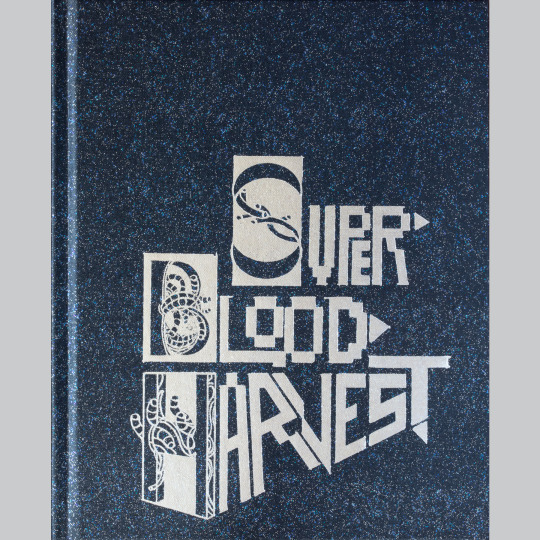
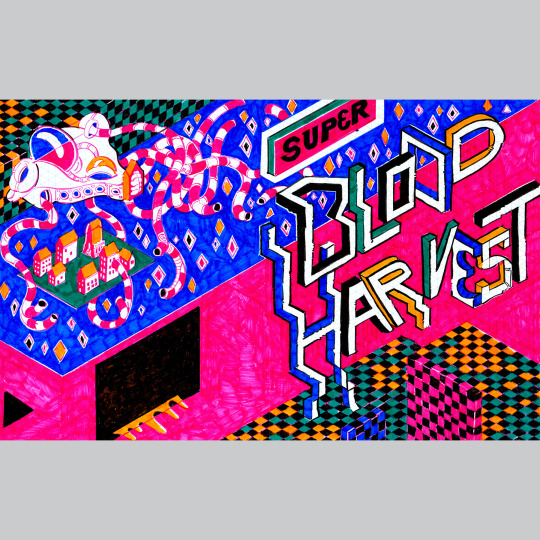
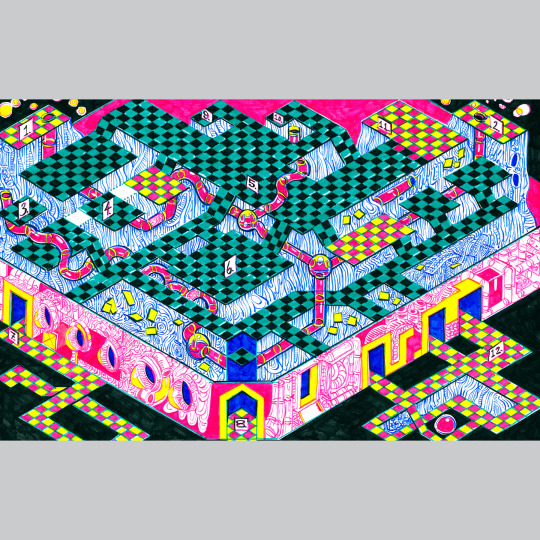
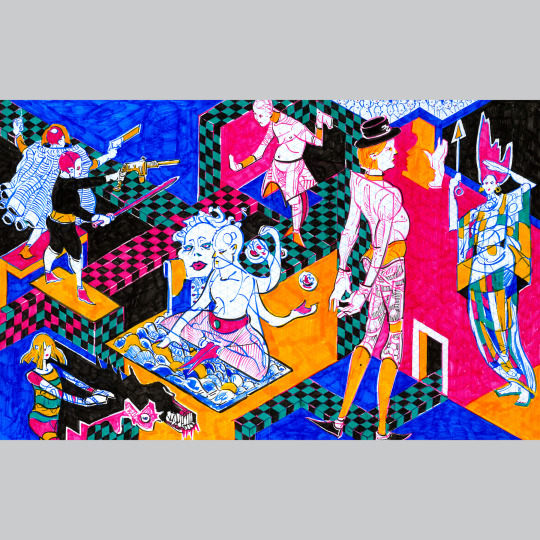
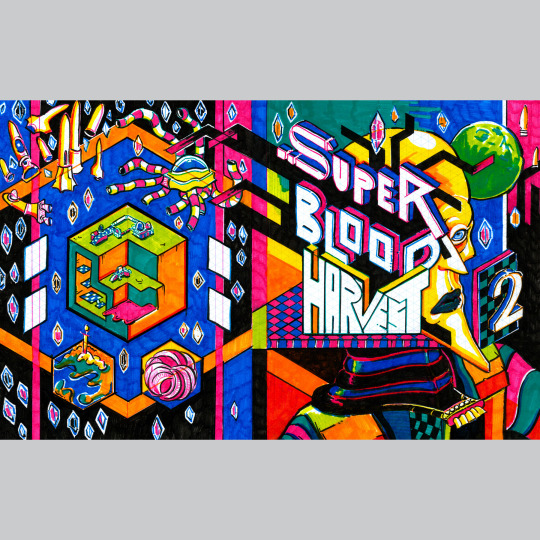
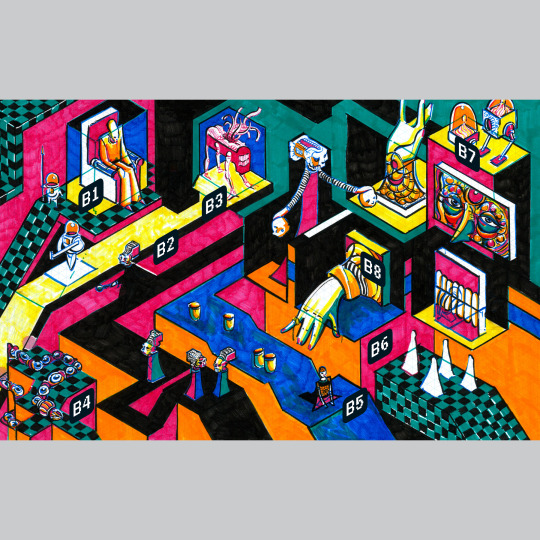
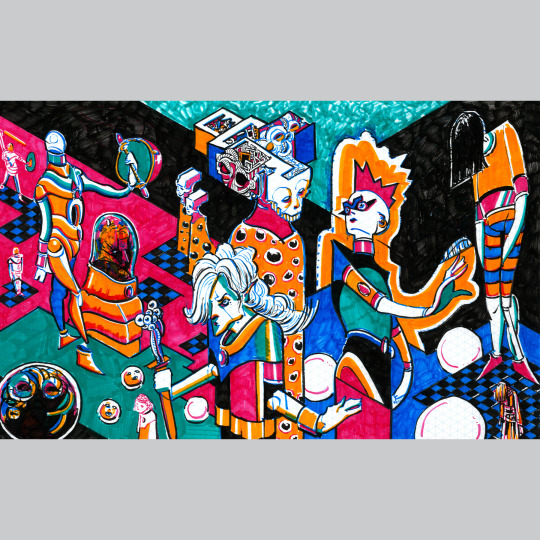
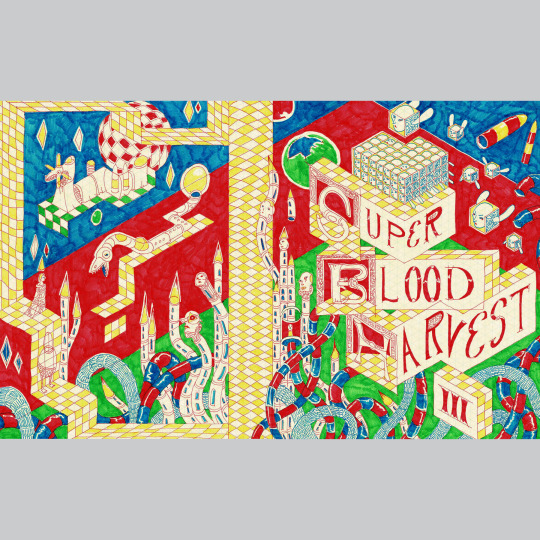
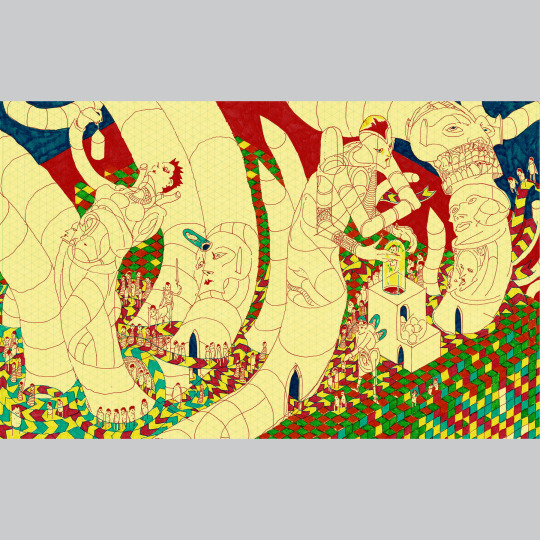
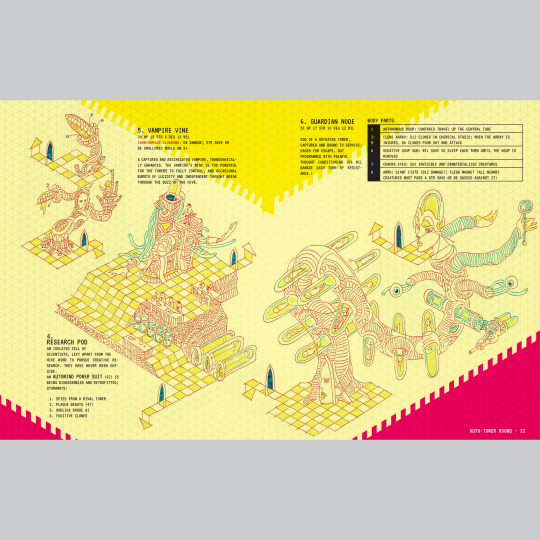
This is the gorgeously weird Super Blood Harvest (2020), by @DirkwithaVengeance, a serious contender for most beautiful RPG book I’ve gotten this year. The book consists of three standalone-but-thematically linked scenarios – Escape the Blood Ship, Crashed on the Moon, Killbot Guardian Gods – and a set of very light rules, cheekily titled Dirk Rules!, for use in play.
There is a vein of videogaminess running through SBH. That “Super” in the title is the first hint. Each scenario had a kind of meta vibe of being part of an old school game franchise, with each sequel being familiar yet increasingly bizarre. Each scenario ends with a “game over” screen. Quiet nods to Castlevania, Metroid and other videogames abound.
And plenty of other references, too. They’re not the star of the show though – Dirk’s decidedly non-Euclidian art is and it does most of the heavy lifting, with the text being fairly terse (which is good, because terse, I increasingly find, also mean extremely usable). I don’t honestly have words that do his art justice, so just flip through the images here and revel.
All of the scenarios are accompanied by a set of six pregenerated characters, each set as increasingly bizarre as the adventure they are to star in. The first scenario involves being kidnapped by space vampires who needed to refill their ship’s blood reservoir before hibernating behind the moon. The second sees the ship crash on the moon, where new characters discover the vampire temple and the god they imprisoned there to worship (and some Venusians). The third, my favorite, moves the action to Mars after the fall of the vampire empire (hundreds of years later?) where humanity, insane machine entities, vampires and less easily described entities crash into conflict. SBH3 is the most ambitious and sprawling of the scenarios, reminiscent of the way Vault of the Drow sketches out a sandbox campaign setting. Though a pretty fast read, there are hours and hours of very strange play awaiting you here.
#RPG#TTRPG#Tabletop RPG#Roleplaying Game#D&D#dungeons & dragons#Super Blood Harvest#Swordfish Islands#Dirk Leichty
45 notes
·
View notes
Text
Silent Titans

So: “Silent Titans”, an RPG setting / adventure with text by Patrick Stuart and art by Dirk Detweiler Leichty.
Great art and writing in a very handsome volume. (To my hands, it feels better-made than the current-edition D&D tomes; publisher Jacob Hurst’s previous efforts were the Hot Springs Island books, similarly lavish.) Here it is on the leaf-strewn floor of my living room:
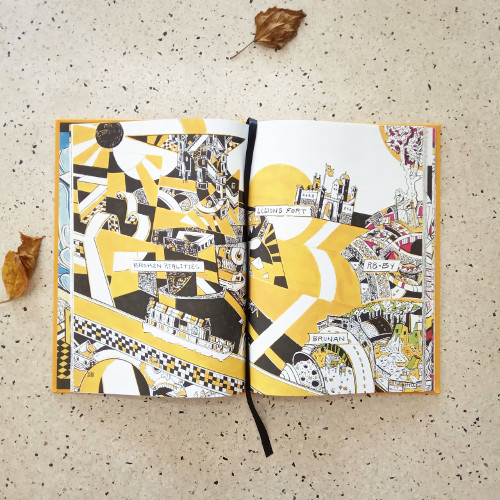
And since I have a terrible phone camera that refuses to focus, some screenshots from the “Silent Titans” PDF:


Virtually every review I’ve read of “Silent Titans” has been glowing. Here’s a fun one: a lit-crit deep reading of the text.
It’s up for a battery of 2019 ENnies -- Cartography, Writing, Production Values, Product of the Year. I guess this doubles as my ENnie endorsement post? You should vote for “Silent Titans”, when the time comes. (Or “Mothership”. Or “Troika!”. Or Luka Rejec’s “Ultraviolet Grasslands”. All of those are good.)
+
I’m a Patrick Stuart fan. “Silent Titans” doesn’t change this.
The book’s setting, Wir-Heal, is at once English-countryside pastoral and post-modern dreary, and hopelessly warped by the presence of the titular Titans -- “quasi-living multidimensional hyper-intelligences from an unimaginably distant future”.
Think future-Cthulhus, whose nightmare-dreamings are leaking into the reality of the land under which they lie.
And what nightmares these are! Take the Predator Lane: a living highway that chases player-characters like a “wolf tracking their scent”.
Or the Radio Noise Men: “patches of screeching radio noise in humanoid shape”.
Or Targeted Individuals: “silent, people-shaped, racing heat-images”, with crosshair-ed screens for faces. Their face-screens display their target -- you! -- from a top-down, spy-satellite perspective, and this zooms in as they run towards you. They blow up when they arrive.
The anthropomorphic representation of drone warfare, as an RPG monster. Holy shit, that’s crazy good.
+
Dirk’s art is a joy to stare at. His stuff is so unlike anything else in RPGs currently. I also love how obviously not-made-on-a-computer it is; such a pleasure, seeing the quality of lines made by a pen touching paper.
That he doesn’t get an ENnie nomination for “Silent Titan” ’s art feels like a snub.
+
If there’s one quibble I have with the book, it’s this: The art and the writing are maybe too appropriate for each other.
“Cracked concrete coast defences, iron exposed. Wrack-caked steps to crow-pecked sand”, mixed with “Fields of wrecked agricultural machines bordered by gates, hedge, barbed wire and cow traps”.
The writing is moody; the images surreal.

The art is mind-bendy in similar ways, as if reality’s perspective lines were dosed with psychedelics.
Which is brilliantly setting-appropriate. But there were times, in the reading (and in the playing; I’ve been in a “Silent Titans” campaign for some months, now), when it was hard to grok the imagery -- how a particular monster looks; what the landscape looks like; which other bit of text this bit of text is alluding to --
and I wished the art was ever so slightly more mundane, more anchored, so my literal brain could grasp things quicker.
But yeah: minor quibble.
+
The adventure + setting stuff feels refreshingly unfamiliar.
This would be a liability elsewhere, but “Silent Titans” understands the need to orientate GMs. Patrick spends some time discussing how to improv detail, atmosphere, and “wholeness”:
“The sense of wholeness I aim for is the same you might have walking through your hometown to the front door of your living space. You know vaguely and generally where everything is and what things would make sense to be where, but you are not obsessively considering every single small detail.”
There are also thorough takes on the principles that underlie interesting RPG encounters:

“Remember: in times of immediate danger, every spatial decision is also a moral decision.”

“If a creature has a deep, resonant poetic reason to be, for instance, “Dumb and Dangerous”, which is integrated into the world and makes sense, then so much the better. But the more important principle is that it have something interesting the PCs can DO with it.”
A good reminder! Especially for the more indulgent writers among us.
These notes alone are worth the price of admission, I think.
+
One of the book’s appendices is an interview with Chris McDowall, whose “Into The Odd” system “Silent Titans” uses.
It’s an insightful little chat:
PATRICK: Is “Into The Odd” a problem-solving game?
CHRIS: For me the dual cores of the game are Exploration and Problem Solving. If you do it really well then either of those can stand alone. I’ve had long chunks of sessions where there isn’t a huge amount of conflict, but the players are just enjoying “Bastion” and laughing at some ridiculous situation or character. Likewise, I’ve had sessions where the world became largely irrelevant in the face of pure dungeon problem solving, but the real magic is when you get them working together.
Both, but problem solving more clearly, are things that tabletop games still do better than videogames. No videogame offers the tactical infinity of a tabletop RPG, so whatever game I’m running I’m going to be looking at how best to focus in on that strength.
It’s one of those elements that often benefits from an absence of mechanics, rather than needing their support, so “Into The Odd” was definitely designed with that in mind.
And this bit about how “rules =/= the game”, in RPGs:
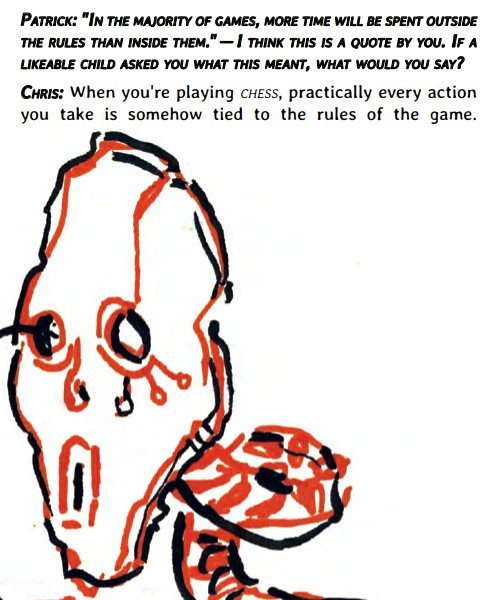

Also worth the price of admission!
+
My favourite thing about “Silent Titans”? It is a love letter to the place Patrick comes from:
“I created ‘Wir-Heal’ based almost entirely on the feel and impression of my home, the Wirral. Its lonely, post-industrial, ‘time-lost’ nature is my literalisation of the feel and mood of the place where I live.”
In his closing notes, Patrick explains that Hugh Lupus, a character in the book, is a real figure from the vicinity of the Wirral -- just as Legion’s Fort, the city he rules, is a phantasm of the actual city of Chester.
Ditto Mister Samuel Moreton, “who really did ride about in an omnibus with a bunch of cronies treating the Court like a street gang using legal powers it took an act of Parliament to remove. But who was not, literally, a Wolf.”
(And I know that the painted boats in Elles Mere is based on real-life painted boats Patrick encountered in some canal. I know this because I seem to remember him blogging about them? But I can’t for the life of me find that particular post.)
"Silent Titan” ’s specificity makes it a somewhat intimate work. It is a glimpse into the author’s own geography, a window into their lived reality. Patrick indulges his fascination with the Wirral peninsula; because of this, the Wirral is made fascinating to us, also.
+
This channeling of the personal and the specific should happen more often, in RPG works. Patrick seems to think so, too. Here he talks about the Wrecked Heptarchy, the blank setting that borders Wir-Heal:
“You almost certainly live somewhere too. Your own part of the Wrecked Heptarchy could be based on your impressions of your home. If you are the kind of imaginative introvert who usually buys this kind of thing its likely that you have already imagined your local streets as zones of adventure, that would be a good place to start.”
+
Get “Silent Titans” HERE.
#reviews#rpgs#patrick stuart#silent titans#dirk detweiler leichty#chris mcdowall#specificity#the wirral
19 notes
·
View notes
Photo






a selection of TROIKA’s wonderful character class art.
source: TROIKA! numinous edition artist: dirk detweiler leichty
#TROIKA!#ttrpg#surreal#osr#fantasy#science fantasy#my favourite class i think is... the parchment witch#the way the paper skin is handled is very fun
92 notes
·
View notes
Text
Adventure Starter: The Curse of Drazhu (by D. Kenny)
Adventure Starter: The Curse of Drazhu (by D. Kenny)
The Curse of Drazhu A campaign starter for Dungeon World (2017 CC BY SA), inspired by Jeremy Strandberg, Dirk Detweiler Leichty & Brian Holland At the beginning of the adventure roll 8d6 and take turns assigning them to the questions below. Set the remaining 2 dice aside. What happened here recently? A great and bloody revolution A devastating plague Famine from unearthly drought, flood…
View On WordPress
0 notes
Link
I broke it the thread down to my top ten aphorisms, with bits stolen from Gregory Blair, Brian Harbron, FM Geist, Zedeck Siew, Brian Murphy, Dirk Detweiler Leichty and Daniel Davis; 1. This is a game about interacting with this world as if it were a place that exists.
0 notes
Text
One Page Dungeon Compendium 2018 Tenth Anniversary Edition
Publisher: Shattered Pike Studio
The 2018 Tenth Anniversary Edition One Page Dungeon Compendium contains 161 "one page" dungeons and adventures! This is the largest compendium to date, with entries ranging from post apocalyptic village raidsand an alternative history 1950's town to classic fantasy dungeon delves and everything in-between.
A retropective on the contest, written by Michael Curtis, is also included.
Two files are included: An optimized PDF, and a much larger PDF with 300 dpi image quality.
Each PDF file is fully hyperlinked for ease of navigation, with the orientation (portrait/landscape) of entries preserved.
Credit for the content contained in this compendium includes the following:
Michael Richards, Michael Curtis, Aaron A. Reed, Aaron Thompson, Kelly Ellerbrook, Aidan Oos-MacFadden, Alan MacPherson, Alejo Silos, Alexander Hobsbawn, Alex Schroeder, Alex Welk, André Bogaz, Camila Morais, Andre Lindenfelser, Andrea Batacchi, Andrew Durston, Heleen Durston, Andrew Bailey, Andrey Plisko, Andy Robinson, Nicole Robinson, Anna Anthropy, Beatrix Urkowitz, Anton L.C., B. Pierce, B. Reid, Ben Chaplin, Ben Green, Benji Dike, Bloodmoon, Bodie Harley, Brad Fiore, Brett Jackson, Brian Koplek, Brother Juniper, bygrinstow, Carl Niblaeus, Carlos Pascual “Azifran”, Caroline Berg, Carolyn Leagues, Chris Hall, Christian Sahlén, Chris Walton, Clark B. Timmins, Connor Roberson, Cooper Graetz, Dan D., Dan Smith, Tisha Parti, Dan Wesely, Daniel Comerci, Daniel F. Walthall, Daniel O’Hare, David Brennan, Derek Ruiz, Dirk Detweiler Leichty, Donald Lamont, Duamn Figueroa Rassol, Eldadres, Eri, Eric Lyonford, Eshan Mitra, Gabriel Perez Gallardi, Gabriel Schrock, Kristine Yabut, Garrett Norman, George Cassie, Glyn Seal, GM Lily, Gregorious21778, Gregory Vangilbergen, Harrison Swift, Herr Zinnling, Lina, Hendrik, and Joaquín, HillbillyDM, Ian Shears, Idiomdrottning, Irvin J. Morales Esqueda, J.D. McNichol, JD Thornton, James Hirst, Jann Rippstein, Tobias Bottger, Jeff McKelly, Jennevieve Schlemmer, Jeremy DS Marshall, Jess Cowrd, Jesse Davidson, Jmar, Joakim Andersson, Joel Russ, Johan Nohr, John Love, Matthew “Ogrebeef” Seagle, John R. Capps, Johnathan Castle, Matt Henderson, Joran Heimering, Karl Stjernberg, Keith Echevarria, Keith “indi” Salamunia, Ken Demarest, Ken Moore, Kevin D. Lintz, Kezle, Khelren, Kosmic Dungeon, Larry Z Pennyworth, Laruen Neuburger, Lowlama, Luiz Comassetto, Luke E. Dodd, Marco Conti, Markus Linderum, Ahn Sanders, Matt Sanders, Matthew Ficken, Nathan Schmitz, Matthew Harvey, Katie Logan, Sylvia Gallagher, Mattias Lejbrink, Max White, McGravin, Michael Perry, Michael Raston, Michael Wenman, Mike O’Regan, Mobralrox, Moritz Fornoff, Nate Treme, Nathan Byrd, Buddy Caperton, Ned Hugar, Nical, Noah Lloyd, Matt Ryan, Olobosk, Pasquale Camuso, Patrick Kelly, Ian Andrews, Philadelphia Hanson-Viney, Hamish McIntyre, Pyry Qvick, Quinn L., Rebecca “Sithel” S., Richard Grzela, Robert Standridge Jr., Roger SG Sorolla, Rose Szabo, Tamora Raze, Ruune Magick, Ryan MacKenzie, SM Hillman, Sadhbh Brennan, Sash Steele, Zachary Cox, Scott Marcley, Sean Ritner, Lisa Healey, Sean Smith, Seth Paxton, Seth Piercey, Shane Starkey, Sharang Biswas, Ben Morgan, Simone Biagini, Simon Forster, Spaghetti Quester, Spencer Hudson, Devin Carey, Sterling Heibeck, Steve Kilian, Stephen Thompson, Stuart Kehoe, theinfamousmrmeow, Theo Olsen, Tim Shorts, Toby Lancaster, Tony Eakes, Travis Cook, Bryan Wuest, Trenton Anderson, Urbini Cristian, Dawei Yao, Vance Atkins, Vincent Raitt, Wilmer Dahl, Wind Lothamer
Price: $3.00 One Page Dungeon Compendium 2018 Tenth Anniversary Edition published first on https://supergalaxyrom.tumblr.com
1 note
·
View note
Photo

Another Amazing Kickstarter (Dust, Fog, and Glowing Embers, an RPG by Slade Stolar —Kickstarter) has been published on http://crowdmonsters.com/new-kickstarters/dust-fog-and-glowing-embers-an-rpg-by-slade-stolar-kickstarter/
A NEW KICKSTARTER IS LAUNCHED:

What if all of the systems that were supplanted by science prevailed? That is, what if science lost? For example: What if alchemy rose to prominence instead of chemistry? What if numerology were the main branch of mathematics? What if the four humours were our explanation of human behavior, rather than psychology? What if the reading of goat entrails were the most accurate method of weather prediction?
From dark alleys to high-street shops trepanning, séances, and blood-letting would be commonplace.
In Dust, Fog, and Glowing Embers, you enter a world at the cusp of its industrial age. You embody characters that have to face a world in which all kinds of strange physical laws apply. This is a science-fiction game, although from the perspective of a version of the proto-industrial past. Your characters are special because they have access to spagyric essences (plant-based alchemical substances that allow them to become as rarefied as mist, light fires by exuding sparks, or whip up dust storms to blind their enemies), which make them the perfect tool for unsavoury people to exploit.
Your pledge will help to create a book (in PDF and print-on-demand formats) that contains the rules and setting of this table-top role-playing game. Aside from pencils, dice, paper, and compatriots, the book will contain all that you need to start telling stories in the world of Dust, Fog, and Glowing Embers.
The BioShock (1, 2, and Infinite) and Fallout (1, 2, 3, NV, and 4) video games are inspirations. The extant table-top RPG Into the Odd has a similar setting. Vampire: The Masquerade has similar powers. From Bioshock and Vampire, I want to take the idea of having incredible powers that feel like they are slowly corrupting you. From Fallout and Into the Odd, I want to take the idea of a setting that is gritty and oppressive and anachronistic, while still being darkly funny.

This game uses the same the core dice mechanics as our previous game The Indie Hack, in which two dice are rolled, one Light, one Dark. The Dark Die represents the character’s prowess. The Light Die represents the challenge that the character faces. The highest result is the winner, with degrees of success based on the difference between the two dice results. Of course, you will add one of your three attributes, namely, Tough, Precise, or Clever, to your Dark Die result.
The main units of narrative that you’ll be adding to the story are called details. Details are properties or conditions (e.g., the ornate pistol you found in the cellar of the judge’s manor might have the details Rusted and Engraved with occult symbols). Details are written down when they are added to a character, scene, enemy, or item, and are crossed out when they are no longer applicable. The better your dice result, the more details you get to add.
The core rules shared by The Indie Hack and Dust, Fog, and Glowing Embers are available in a System Reference Document, which you can use to start making your own hacks: https://scablandspress.com/srd/

Your character is a wretch, an undesirable, an outsider, a pariah. You turn to a Patron to better your life; they exploit you to enrich theirs. They give you spagyric essences to grant you incredible powers, but these substances take a significant toll.
Fleshing out characters and additional world-building occurs at the start of the game. Once you have your group at the table, you follow these steps to create a gamut of complex outcomes:
Create your Patron; your Patron’s lusts will dictate the kinds of tasks you must complete (or risk losing their favour).
Choose your character type, from among Raven, Swan, and Phoenix. Take extreme attributes, more aptitudes, or a balance.

Answer several questions about your place in the world. Where can you never go, and why? How long has it been since you last saw your lover, and why? What causes you the most resentment about being a lackey, and why? What makes you want to destroy your Patron, and why can’t you?
Choose your spagyric powers. Exude cinders to light rooms or start fires, whip up sand to sharpen swords or blind foes, become mist to avoid attacks or slide under doors.
Choose your prime humour, among melancholic, phlegmatic, choleric, and sanguine. Your personality evolves mechanically as you interact with NPCs.

The City of Stome lies at the heart of Our Commonwealth. The streets are built upon layers spanning hundreds of years of compacted waste, bodies, and ruins. The streets are filled with horses, cheroot smoke, and fog. While walking, you pass cloaked, soot-smudged, sweat-sticky people.

The main districts of Stome have their distinct flavours:
Black Hall and the Inner Courts – The Government of Our Commonwealth, including its courts and police stations
The Promenade – A pathway good for brisk walks (enjoyed by lovers and muggers alike)
The Eastern Heights – Opulent manor-houses far from the smog, but with their own (subtler, more insidious) dangers
The Circuit – Factories and slaughterhouses around a ring road
The Wold – Temples of all faiths and vast cemeteries
Beyond the city are farms, forests, and fields, but also:
The Fens – A corridor of swampy wasteland, home only to odd beasts
The Felnwol Caves – Labyrinthine sandstone passages hiding riches from ages past
The Undercity – Black markets and enigmatic characters (worthwhile if you can stand the smells)
Each district will have random tables of themed events that can be used (by the players or the GM) to drag the players into unexpected conflicts and offer unexpected rewards when they “Go looking for trouble”. A sample is shown below.

The nation simply known as Our Commonwealth, unlike Stome, is not yet well defined. We hope to expand upon it in various ways via stretch goals from talented folks in the online RPG community.


Slade Stolar – Has written the engine and setting of the game.

Dirk Leichty – Has drawn some amazing artwork, and will draw yet more. You can see a handful of excellent examples on this Kickstarter page.

Oli Jeffery – Will be doing layout to give this game polish. There’s a sampling below (note that the text and page numbers are not final).


The music that you hear in the video is The Spirit of Russian Love (violin) by Zinaida Trokai by Kosta T. I think it’s beautiful and haunting.
We are asking for your financial support and input (as creative GMs and players) to complete this project in a way that is professional, comprehensive, and effortlessly usable. Art and layout of this high quality can get expensive, and a broad supporter base reduces per-unit costs. Additionally, in many ways, it is impossible for us to know how you would play this game; no amount of internal playtesting would be sufficient to address all the issues that might arise (even ones that are obvious to your group), that is, the powers of the game could be very unbalanced if approached differently. We want to locate and solve any such issues, and to cite you as contributors to the rules. Furthermore, we want this game to be hackable; we need to know how to make the core ruleset work for you beyond the world of Dust, Fog, and Glowing Embers.
Note that all submissions by Contributors and Patrons are subject to in-good-taste approval by Scablands Press.
The current budget is as follows:
Kickstarter Goal: $2,200 CAD
Artwork – $800 CAD, which includes the cover and over 15 illustrations in the style seen above, such as enemies, characters, items, and a map
Layout – $340 CAD, which means creating pages like those above; backgrounds, ink splats, and other embellishments
Editing – $530 CAD, which means professional editing of the document
Fees and Taxes – $530 CAD, which seems high, but includes my income taxes for the KS funds (I will declare this as income) and the KS-based fees
$4,000 CAD – [Locked] – The Burialmounds, a setting PDF by Thomas Novosel, given to all at Digital Copy level and above.
When the flesh begins to harden, the skin starts to crack, and the mind becomes scattered across the wind, it is a sign. It is a sign that your existence can no longer hold itself together after you have–time and again–weakened it. You blow away, only to materialize on the Burialmounds. This floating mass of dirt and consciousness pulls itself through the sky with tendrils of rattling chains. It is a prison for those who have abused the spagyric powers that have been discovered.
The Burialmounds is where spagyrists often find themselves when they can no longer hold their bodies together on their own. It acts as an anchor for the warped and anatomically volatile that drifts aimlessly across the lands and seas, holding The Damaged, Vultures (a new player class), and powers that only the most broken may conjure from the void beyond this world.
$6,000 CAD – [Locked] A Mystery Setting Supplement, given to all at Digital Copy level and above.
$8,000 CAD – [Locked] A Mystery Guest’s Hack, given to all at Digital Copy level and above.
$12,000 CAD – [Locked] Another Mystery Setting Supplement, given to all at Digital Copy level and above.
$16,000 CAD – [Locked] A high-quality hardcover digital offset print run. Heavy paper. Rich ink. Available to all at Digital + PoD Physical Copy level and above; just pay printing and shipping (however, at the Digital + Physical Copy Shipped to You level, don’t pay anything more).
Every $4,000 CAD thereafter – [Locked] ???
More stretch goals will be revealed as they are unlocked.

Printing and shipping are always difficult parts of planning a kickstarter that involves a book. We are working with DriveThruRPG.com to bring you high-quality physical print-on-demand products and integration with a massive online collection of existing role-playing games at the lowest possible prices.
Print-on-demand books will ship from the United States or the United Kingdom. Estimated standard shipping prices for softcover books are as follows (all prices in USD):
USA – $5 USD
UK – $6 USD
Germany – $7 USD
France – $8 USD
Canada – $7 USD
Using DriveThru, you can combine your physical print-on-demand reward with other items to reduce your per-item shipping costs.
Additionally, you’ll be able to choose your print quality:
Standard quality softcover – $4 USD
Premium quality softcover – $14 USD
Standard quality hardcover – $9 USD
Premium quality hardcover – $19 USD
Note that final printing costs will be based on final page count.
DriveThruRPG lets us at Scablands focus on making the best possible product, rather than worrying about fulfillment.
INFORMATION PROVIDED BY Kickstarter.com and Kicktraq.com VISIT PAGE SOURCE
0 notes
Text
I Missed the Kickstarter, but My Patience Has Bounds Only Reaching to Yesterday
well Silent Titans is up for pre-order. As anyone who’s anyone knows, i have a particular fondness for Into the Odd, quirko-bizarre rpgitude, also art. i am very excitable. i will probably spend my monies now on the Bonus Bundle and sit in agitated anticipation for what i am sure will be something.



#Silent Titans#OSR#Into the Odd#lol i'm actually just assuming it's I2tO#but it's got stuff from#Chris McDowall#Patrick Stuart#Dirk Detweiler Leichty
1 note
·
View note
Photo





Bring Me Her Bones (2021) is by Dirk Detweiler Leichty and adheres to a blue and green color scheme. Of all the Manifestus Omnivorous zines, this is the one that pushes against the rules the most, I think. For instance, it is a bit less of an adventure, say, than it is a setting. Nor is it technically one location, unless “the city” counts and its constituent locations do not. These are nitpicks though. I love this thing.
Big picture: the king is an asshole who sold his soul to the Green Sun for prosperity for 66 years. Time’s up, so he’s started worshiping the Beast in hopes of finding an out. The Beast is down to help, but wants the King’s daughter’s bones, so it can eat them (which will make her his wife in hell?). The problem: the princess is missing. Hence the title.
The adventure is structured a little unusually, consisting of exploration turns that are complicated by astrological omens (determined by dropping dice on the evocative map). There are places to visit, treasures to unearth, murders to solve. Factions complicate things. The King’s agenda, of course, is not public, but the cult of the Beast is working to see the marriage consummated. The princess’s brothers, a pair of bungling wizards, also hunt for her. Princess Europa is the standout character, a resourceful master of disguise, attempting to free her one true love before escaping the city. She’s a worthy opponent for both her friends and foes.
I’m generally on record as to loving Leichty’s geometric art. I think this stands among his best, even with the limited palette — there is something about the obscurity of the astrological element that I think he is particularly well suited in portraying.
#RPG#TTRPG#Tabletop RPG#Roleplaying Game#D&D#dungeons & dragons#Games Omnivorous#Manifestus Omnivorous#Bring Me Her Bones#Dirk Detweiler Lechty
76 notes
·
View notes
Photo







Dancing with Bullets Under a Neon Sky (2021? Folks, please, put copyright dates in your very nice books! For posterity!) is a slim 64-pages, but contains a frankly astonishing distillation of the cyberpunk genre.
The underlying system uses the Black Hack, but Chance Phillips has tinkered quite a bit. The big one is introducing a dice chain to replace hit points (get hit, fail a check, your to-hit die goes from a D8 to a D6) — this is super novel and dangerous (it seems likely for a single failure to lead to a death spiral). I kind of love it — Warhammer 4E uses this massive system and tokens and stuff to try to simulate the momentum of battle, but here’s this simple, elegant mechanical depiction of the same thing.
Anyway, I digress. About a quarter of the book is character generation, another quarter is rules for gameplay (“what can I steal?” is a whole chapter). An implied setting emerges from the combo of this material and your preconceptions about the cyberpunk genre — again, the word I think of to describe this is elegant. There isn’t room to waste on endless lore prose, to Phillips outsources most of the creative work to the reader’s brain and the best part is you don’t even realize you’re doing it. But I bet if you read this book, you can get a rip roaring cyberpunk game to the table in about twenty minutes. The back half of the book is just random table after glorious random table. If the rules give you the big outline, the tables give you the raw material to start filling in the details. The book is gorgeous too. I am a sucker for Dirk Detweiler Leichty’s art and it is particularly suited for cyberpunk. That metallic foil and high gloss on the cover is also extremely Good.
#RPG#TTRPG#Tabletop RPG#Roleplaying Game#D&D#dungeons & dragons#Exalted Funeral#Chance Phillips#Dancing With Bullets Under a Neon Sky#Black Hack#Cyberpunk#Dirk Detweiler Lechty
85 notes
·
View notes
Photo









Let’s start the week with something jaw dropping: this is Silent Titans (2019), by Patrick Stuart, illustrated by Dirk Detweiler Leichty. It uses a light version of Chris McDowall’s Into the Odd rules (so light they fit on a bookmark). It is weird.
You have fallen through time, lost your memory and are exploring the Wir-Heal, a place where time and space have been poisoned by the dreams of those sleeping Titans. Animals in the Wir-Heal wear strange masks and talk. If humans stay too long, they turn into green haired, grass eating beasts. It may not be obvious at a glance, but there is a central mystery to solve. To deal with all of this means dealing with the Titans – you need to pull out their ego machines so they fall more fully asleep and stop making reality vomit all over itself.
For an RPG that you might think is “gonzo,” Silent Titans does a good job of holding your hand through it all. Yes, the maps are strange (all the images in this post are dungeon maps, by the way – let that sink in) and the art is bonkers, but the text is grounded, full of excellent GMing advice and presented largely in bulleted lists, which makes it easy to parse (sort of – Stuart does like flowery language, even in bullets). The experience of Silent Titans is bizarre, but the execution is playable.
The art speaks for itself. It is rare in RPGs to have art so beautiful be so integral to understanding the world of the game. They could have presented Silent Titans in a more traditional way, just like you can choose to run it using your preferred OSR system instead of Into the Odd, but then it wouldn’t be Silent Titans anymore. This was designed to be a particular experience. That is rare and wonderful.
With 45 or so years of RPG history under our belts, we tend to think more about what RPGs are and less about what they could be. Silent Titans is 100 pages of Could Be – gorgeous, boundary pushing potential, waiting to blow your mind.
Join us on Patreon!
#RPG#TTRPG#Tabletop RPG#Roleplaying Game#D&D#dungeons & dragons#Patrick Stuart#Dirk Detweiler Lechty#Silent Titans#Into the Odd#Swordfish Islands
41 notes
·
View notes
Text
Troika!

When I got Daniel Sell’s Planescape-meets-Fighting Fantasy-but-odder RPG Troika! in PDF I screenshot-ed its intro paragraphs:

“ excuse me but I think @Ignus1 has written the best introduction to roleplaying games ever I think the rest of us can go home now ”
was what I said about it on Twitter.
When I got it in hardcopy -- book arrived this week -- I read it cover to cover. One sitting. This rarely happens with books, for me, and never with RPG books.
I’m a little bit in love, maybe.
+
Three things stand out.
One: the prose has a real ease to it.
There’s no door-stopping chapter about Troika!’s setting. All its world-building is done via available character background options; the item and spell and monster lists; the odd intro adventure in the back of the book.
Here’s one of the player-character backgrounds you could roll:
“65 YONGARDY LAWYER
Down in Yongardy they do things differently. They respect the Law. Every day there is a queue outside the courts to get a seat to see the latest up and coming barrister defend their case with three feet of steel. The people follow the careers of their favourite solicitors, watch all their cases, collect their portraits, and sneak into the court after hours to dab the patches of blood on white handkerchiefs.
In Yongardy, they love the Law.”
Here’s how the “Befuddle” spell is described:
“A wizard’s touch can shake up someone’s mind like a snow globe. The target makes all rolls at a -1 penalty until their head clears. Lasts for 3 minutes.”
This isn’t 100% natural language. But even when Daniel is explaining the rules for armour or initiative (initiative being the ruleset’s weirdest feature) his style is pithy, evocative, a pleasure to read. " ... like a snow globe.”
Like Luka, I do think that RPGs could be written better. And I think Troika! does that.

+
Two: where Daniel designs from.
Not sure how else to put this; I’m not a rules or design person. Maybe some examples will help.
There’s the introductory salutations above. Here’s a bit in character creation:
“Roll randomly to determine your starting Background. Notice that they only touch the edge of specificity: it is up to you to tailor them to the worlds you play in. Rework them or remove them entirely and replace them with your own unique vision of the spheres. Boldly lay claim to the games you play, create content recklessly, and always write in pen.”
The following is from a Q&A section that starts off Troika!’s intro adventure, “The Blancmange & Thistle”, essentially a six-floor walk up a hotel full of weirdos:
“I don’t know what’s going on! None of us do. Ride it out and see what happens! You can apply meaning and history to everything in your next session in light of the events of the first. Encourage the players to connect the dots for you.”
The whole book has a: “You’ve got this! I believe in you! YES!” tone to it.
As a system Troika! is pretty loose. It provides just enough for a foundation, then exhorts the GM and players to build upon that foundation.
I know this will rankle the kind of players who need boundaries to optimise up to and argue against --
But I like it. It is game design that springs from a sense of trust. The system assumes players can and will find their own fun; resolve conflicts in ways that are considerate to each other. In the absence of a higher Designer-God to enforce balance or scold bad behaviour, you only have each other.
Patrick, in his review, observes:
“You could, if you wanted to, make a kind of soft social-justicy, vaguely anarchist, James C. Scottish argument here about very rules-light systems minimising authority structures and necessitating flat and collaborative social arrangements because there is simply not enough to argue about and because the necessary lacunae in rules description silently urge the players and DM to work together to resolve problems of mutual description without ever demanding that they work together in a flat social structure. Guidance through silence and opportunity rather than through warning and control.”
That rings true, to me.
Considering my past experience with tightly-wound, defensive rulesets meant to prevent exploits or steer play along “correct” tracks -- like Torchbearer -- it should be obvious which kind of design I prefer; which kind I think is more humane.

+
Three: how the damn book feels.
Have come to realise that if I only have a book in PDF form I never read it closely enough to write about it. Guess a book’s hand-feel is really important to me?
Troika! feels damn good. I love the matte softness of its pages, the warmth of its colours. Something about its palette really edifies the art -- by Jeremy Duncan, Dirk Detweiler Leichty, Sam Mameli, and Andrew Walter; a veritable dream team. (The non-digital pen-work looks particularly nice.)
I’ve got a new book to show off to my friends.
+
GET IT HERE. (And get it in dead-trees format. So worth it.)
45 notes
·
View notes
Text
DIY D&D, October 2018

Google Plus, where I found all my best nerd-friends, is closing down. It was where I found the DIY D&D / Old School Renaissance community. This community:
Gave me my best roleplaying game experiences; Gave me the confidence to start writing RPG material; Taught me a lot about building a functional community.
I’ve gotten paychecks from people in DIY D&D. I’ve gotten postcards. In this day of social-media instant connectivity? Postcards. In my mailbox. With actual ink, and a stamp.
+
Google may be killing G+, but DIY D&D isn’t going away.
The OSR started as a network of blogs. Here’s a list. (Here it is as a thingy you can plug into your RSS reader.)
People are moving en masse to different platforms. Here’s a massive Discord server. Here’s a cool forum. Here’s a nice MeWe group.
+
Zak S has a questionnaire up for DIY D&D types. I’m answering because it’ll brew a snapshot of the scene + myself, as part of the scene.
OSR Guide For The Perplexed Questionnaire
1. One article or blog entry that exemplifies the best of the Old School Renaissance for me:
“... after a run-in with some "filthy dwarf-types" (kobolds from the wandering monster list) Max lopped off a monster-leg and stuck it in his backpack. At the time, I thought he was just being weird. But later he very effectively distracted some white apes by throwing the grisly limb among them. The apes were much more willing to brawl among themselves over a quick snack rather than fight people bearing torches and swords. Max wasn't content to let his brief character sheet dictate what he could and couldn't do. He went out there and grabbed that dungeon by the collar and gave it a good shaking. And here's the kicker: Max is twelve years old and today was his first time playing D&D!”
All Hail Max, Jeff Rients. Pretty basic stuff, at this point. Still pretty fucking baller.
2. My favorite piece of OSR wisdom/advice/snark:
“The thing I really really dislike about how people use terms like problematic and "interrogate" "critical awareness" etc is they rarely (if ever) provide a framework to objectively measure harm or benefit. So if you say "classic adventures are problematic because it's kinda like a Victorian narrative about invading people and taking their stuff" that's your subjective opinion , which then , when one publishes or writes something extremely similar, you can turn around and declare you have "critical awareness" , and therefore not problematic. Which is utterly perfect for performing wokeness for marketing purposes while never actually doing anything different, e.g Evil Hat's whole business model Compare this to saying to pointing out something which can be used to hold ones on behaviour to a standard: "There are very little women artists in rpgs", "there needs to be more takes on colonialism other than one favourable to the invader" "freelance writers don't get paid a living wage" Then , you yourself can demonstrate that you are actually committed to your wokeness by doing something you can be held accountable for. Because you actually pay people, hire people and publish people in ways that benefit the people whose struggle you are using for marketing purposes.”
Scrap Princess, from this excellent G+ thread. Saying stuff that needs to be said about woke white indie RPG creators who’ve made a career handwringing about how games might be sexist / racist / colonialist / queer-phobic / etc --
But who never quite get around to hiring or paying non-white people / queer people.
(PS: the OSR does. Zak’s paid me. Hydra Cooperative is publishing something I wrote.)
3. Best OSR module/supplement:

“Veins of the Earth”. That blackest brick of a book. I love it most.
4. My favorite house rule (by someone else):
I like usage die! “Torches (d6)” means you roll d6 after every turn that torch is used? 1-2, it drops a die size. 1-2 on a d4 means it’s gone. From The Black Hack, I think?
5. How I found out about the OSR:
Back-of-the-book blurbs, for real. Le Guin, who blurbed China Mieville, who blurbed Scrap & Patrick’s “Fire on the Velvet Horizon”.
6. My favorite OSR online resource/toy:

Not really a utility, more a personal thing. The Lavender Marshes. Filling in a few of its hexes was my first taste of Gygaxian Democracy. Thank you, Ramanan S.
Otherwise, Links to Wisdom.
7. Best place to talk to other OSR gamers:
It is still G+, right this very moment ...
8. Other places I might be found hanging out talking games:
Feel free to add me, at these places:
Facebook: https://www.facebook.com/zedeck.siew Twitter: https://twitter.com/zedecksiew Discord: zedeck.siew#4237 MeWe: mewe.com/i/zedeck.siew
And these forums, I guess?
(I really want to do comments on this blog, too. But Tumblr makes it fiddly.)
9. My awesome, pithy OSR take nobody appreciates enough:
“Play your character, not the screenwriter writing your character.”
Because I hate hate HATE games trying to get into Creative Writing 101 rules-of-good-narrative nonsense.
10. My favorite non-OSR RPG:
Warhammer Fantasy Roleplay, because I have a strange inexplicable love for Warhammer.
11. Why I like OSR stuff:
Nowhere else in roleplaying games do you get writing this fecund, this poetic, this muscular, this good. Serious: I’m in with the DIY D&D crowd because of the writing.
12. Two other cool OSR things you should know about that I haven’t named yet:
Khairul Hisham is a old-school Star Wars nerd who’s written about Malay-language references in Star Wars; Dirk Detweiler Leichty should get gallery shows:

13. If I could read but one other RPG blog but my own it would be:
Patrick Stuart still has my heart.
14. A game thing I made that I like quite a lot is:
How to kill a god, and then turn it into a mine.
15. I'm currently running/playing:
Patrick’s running Yoon-Suin using Johnstone Metzger’s “The Nightmares Underneath”; Camilla Greer’s running Luka Rejec’s Ultraviolet Grasslands with The Black Hack 2E.
16. I don't care whether you use ascending or descending AC because:
Honestly I wasn’t around for this particular nerd bush-war, so I haven’t the faintest what’s ascending vs descending AC is even about???
17. The OSRest picture I could post on short notice:
Is at the top of this post. (Source)
The roundabout ingenuity required to turn the arse of a demon entity from mad alter realities into something as mundane as a cannon is totes OSR.
20 notes
·
View notes
Text
Campaign Starter: Sailing the Sapphire Isles
Campaign Starter: Sailing the Sapphire Isles
Sailing the Sapphire Isles A campaign starter for Dungeon World by Jeremy Strandberg (2017 CC BY SA), inspired by Dirk Detweiler Leichty & Brian Holland Before creating characters, roll 8d6 and take turns assigning them to the questions below. Set the remaining 2 dice aside. What happened here recently? A storm that’s left you crippled and shorthanded A narrow escape from an Imperial…
View On WordPress
0 notes